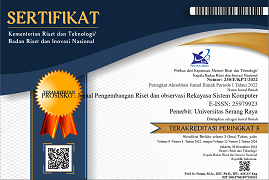DETEKSI LOKASI OBJEK DALAM GEDUNG BERBASIS IEEE 802.11 MENGGUNAKAN METODE K-NN
Abstract
IEEE 802.11 merupakan standar jaringan nirkabel yang paling sering digunakan. Keberadaan teknologi ini sangat menarik dan dapat diaplikasikan untuk estimasi lokasi objek dalam gedung menggunakan infrastrukutr WLAN dengan memanfaatkan RSS (Received Signal Strength) yang diperoleh dari AP yang telah tersedia. Penelitian ini difokuskan pada pemanfaatan RSS yang berasal dari AP yang terpasang di dalam dan di sekitar gedung UPY Unit I tanpa melakukan pemasangan AP tambahan. RSS fingerprint diambil dari lantai 2 dan lantai 3 untuk mengetahui kemampuan untuk membedakan posisi antar lantai gedung. Penentuan estimasi lokasi objek ditentukan menggunakan algoritma k-Nearest Neighbor (k-NN). Dari hasil penelitian diketahui bahwa algoritma k-NN dapat digunakan untuk mendeteksi lokasi objek dalam gedung bertingkat berbasis sinyal WiFi. Berdasarkan pengujian diperoleh nilai akurasi rata-rata sebesar 3,3 meter. Selain itu sistem ini juga mampu menentukan di lantai berapa posisi objek berada.References
Bahl, P., & Padmanabhan, V.N. (2000). RADAR: An in-building RF-based user location and tracking system, in: Proceedings of IEEE Infocom 2000, Tel Aviv, Israel, Vol.2, pp.775–784.
Beauregard, S. (2007). Omnidirectional pedestrian navigation for first responders, in: Proceedings of the 4th WPNC, Hannover, Germany.
Bensky, A. (2008). Wireless Positioning: Technologies and Application, ser. GNSS technology and application series. Artech House Publishers.
Caffery, J. (2000). Wireless Location in CDMA Cellular Radio Systems, Kluwer Academic Publishers.
Caffery, J., Stuber, G.L. (1998). Overview of radio location in CDMA cellular system, IEEE Commun. Mag., vol. 36, no. 4, pp. 38–45, April 1998.
Castro, P., Chiu, P., Kremenek, T., & Muntz, R. (2001). A probabilistic room location service for wireless networked environments, Ubiquitous Computing 2001.
Chan, C.L., Baciu, G., & Mak, S.C. (2009). Using Wi-Fi Signal Strength to Localize in Wireless Sensor Networks, in: Proceedings of International Conference on Communications and Mobile Computing, vol 978-0-7695-3501-2/09.
Fox, D., Hightowerand, J., Liao, L., Schulz, D., and Borriello, G.. (2003). Bayesian filtering for location estimation, in: Proceeding of IEEE Pervasive Computing, vol. 02, no. 3, pp. 24–33.
Gelb, A. (1974), Applied Optimal Estimation, MIT Press.
Hassan, A., and Pahlavan, K. (1998). Site-specific wideband and narrowband modeling for indoor radio channel using ray-tracing, in: Proceedings of the PMIRC’98, Boston, MA.
Hightower, J., Want, R., & Borriello, G.. (2000). SpotON an Indoor 3D Location Sensing Technology Based on RF Signal Strength, Technical Report, University of Washington, February 2000.
Javier, R., & Carlos, J.E.C. (2010). Dynamic path-loss estimation using a particle filter, in: IJCSI Publication, 1694-07842010, Vol.7, Issue 3, No. 4, May 2010.
Kupper, A. (2005). Location Based Services: Fundamentals and Operations, John Wiley & Sons.
Liu, H., Darabi, H., Banerjee, P., & Liu, J. (2007). Survey of wireless indoor positioning techniques and systems, in: Proceedings of IEEE Transaction on Systems, Man, and Cybernetics, vol. 37, no. 6, pp. 1067–1077, November 2007.















